Pathophysiology of COPD2 chronic obstructive pulmonary disease
VerifiedAdded on 2021/06/18
|16
|3343
|92
AI Summary
COPD2 chronic obstructive pulmonary disease exacerbation 1 Chronic obstructive pulmonary disease Name: Institutional affiliation: Pathophysiology of COPD Chronic Obstructive Pulmonary disease (COPD) is a form of obstructive lung disease where there is a change in the normal structure of central airways, peripheral bronchioles and lung parenchyma. Elastases (Human leukocyte elastase) and an increase in oxidative stress caused by free radicals of Cigarette are usually the primary offender that usually cause the cascade of events that lead about lung
Contribute Materials
Your contribution can guide someone’s learning journey. Share your
documents today.
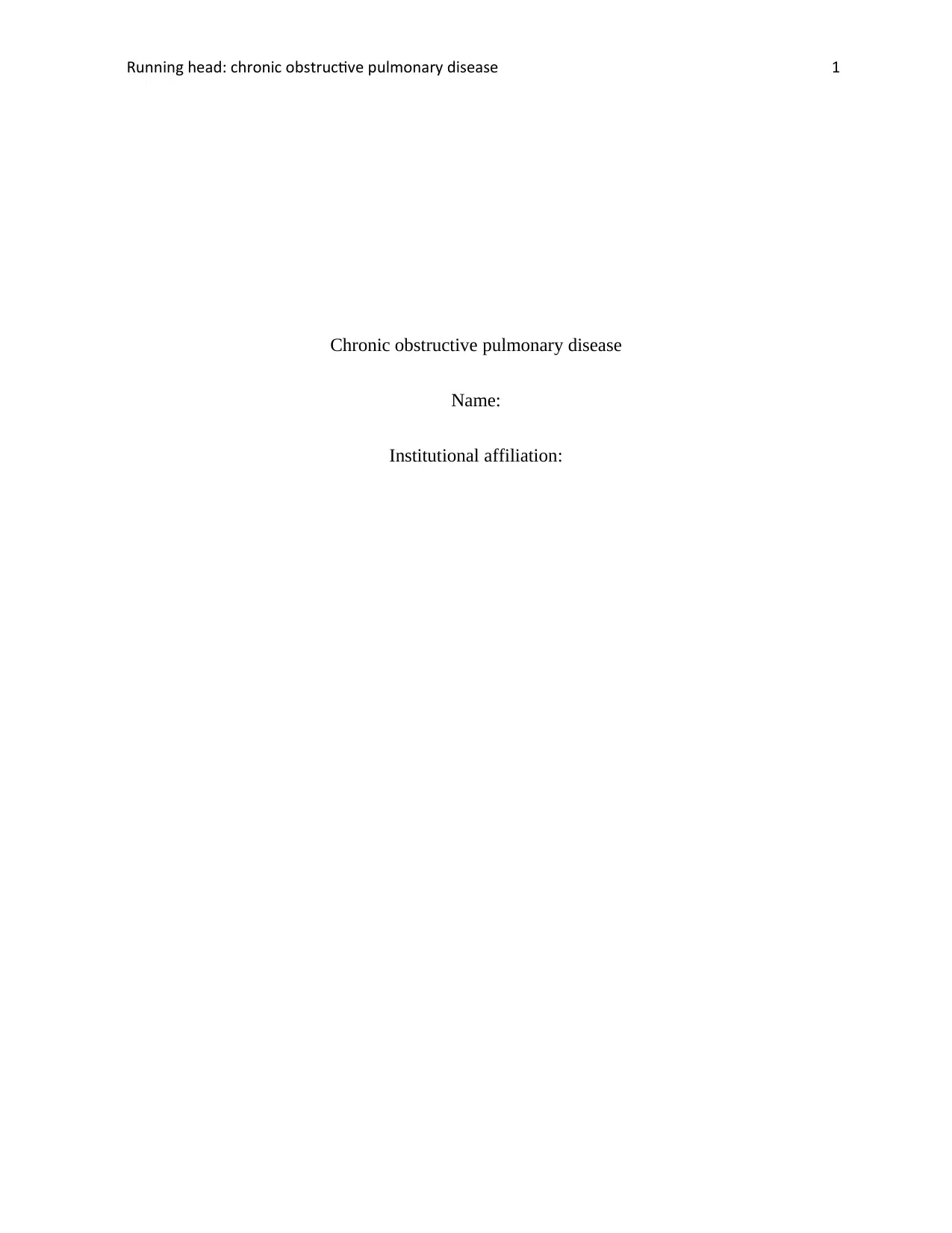
Running head: chronic obstructive pulmonary disease 1
Chronic obstructive pulmonary disease
Name:
Institutional affiliation:
Chronic obstructive pulmonary disease
Name:
Institutional affiliation:
Secure Best Marks with AI Grader
Need help grading? Try our AI Grader for instant feedback on your assignments.
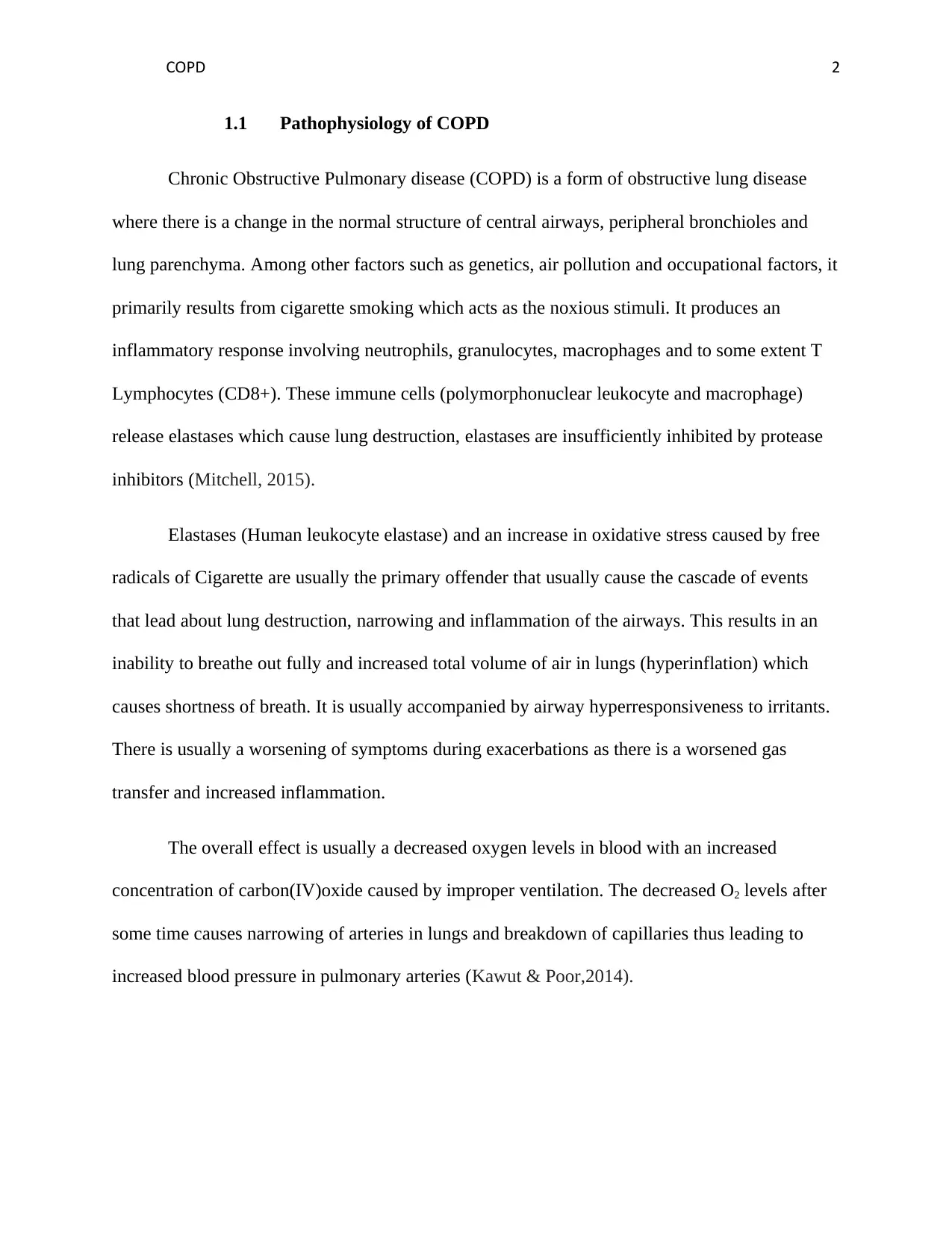
COPD 2
1.1 Pathophysiology of COPD
Chronic Obstructive Pulmonary disease (COPD) is a form of obstructive lung disease
where there is a change in the normal structure of central airways, peripheral bronchioles and
lung parenchyma. Among other factors such as genetics, air pollution and occupational factors, it
primarily results from cigarette smoking which acts as the noxious stimuli. It produces an
inflammatory response involving neutrophils, granulocytes, macrophages and to some extent T
Lymphocytes (CD8+). These immune cells (polymorphonuclear leukocyte and macrophage)
release elastases which cause lung destruction, elastases are insufficiently inhibited by protease
inhibitors (Mitchell, 2015).
Elastases (Human leukocyte elastase) and an increase in oxidative stress caused by free
radicals of Cigarette are usually the primary offender that usually cause the cascade of events
that lead about lung destruction, narrowing and inflammation of the airways. This results in an
inability to breathe out fully and increased total volume of air in lungs (hyperinflation) which
causes shortness of breath. It is usually accompanied by airway hyperresponsiveness to irritants.
There is usually a worsening of symptoms during exacerbations as there is a worsened gas
transfer and increased inflammation.
The overall effect is usually a decreased oxygen levels in blood with an increased
concentration of carbon(IV)oxide caused by improper ventilation. The decreased O2 levels after
some time causes narrowing of arteries in lungs and breakdown of capillaries thus leading to
increased blood pressure in pulmonary arteries (Kawut & Poor,2014).
1.1 Pathophysiology of COPD
Chronic Obstructive Pulmonary disease (COPD) is a form of obstructive lung disease
where there is a change in the normal structure of central airways, peripheral bronchioles and
lung parenchyma. Among other factors such as genetics, air pollution and occupational factors, it
primarily results from cigarette smoking which acts as the noxious stimuli. It produces an
inflammatory response involving neutrophils, granulocytes, macrophages and to some extent T
Lymphocytes (CD8+). These immune cells (polymorphonuclear leukocyte and macrophage)
release elastases which cause lung destruction, elastases are insufficiently inhibited by protease
inhibitors (Mitchell, 2015).
Elastases (Human leukocyte elastase) and an increase in oxidative stress caused by free
radicals of Cigarette are usually the primary offender that usually cause the cascade of events
that lead about lung destruction, narrowing and inflammation of the airways. This results in an
inability to breathe out fully and increased total volume of air in lungs (hyperinflation) which
causes shortness of breath. It is usually accompanied by airway hyperresponsiveness to irritants.
There is usually a worsening of symptoms during exacerbations as there is a worsened gas
transfer and increased inflammation.
The overall effect is usually a decreased oxygen levels in blood with an increased
concentration of carbon(IV)oxide caused by improper ventilation. The decreased O2 levels after
some time causes narrowing of arteries in lungs and breakdown of capillaries thus leading to
increased blood pressure in pulmonary arteries (Kawut & Poor,2014).
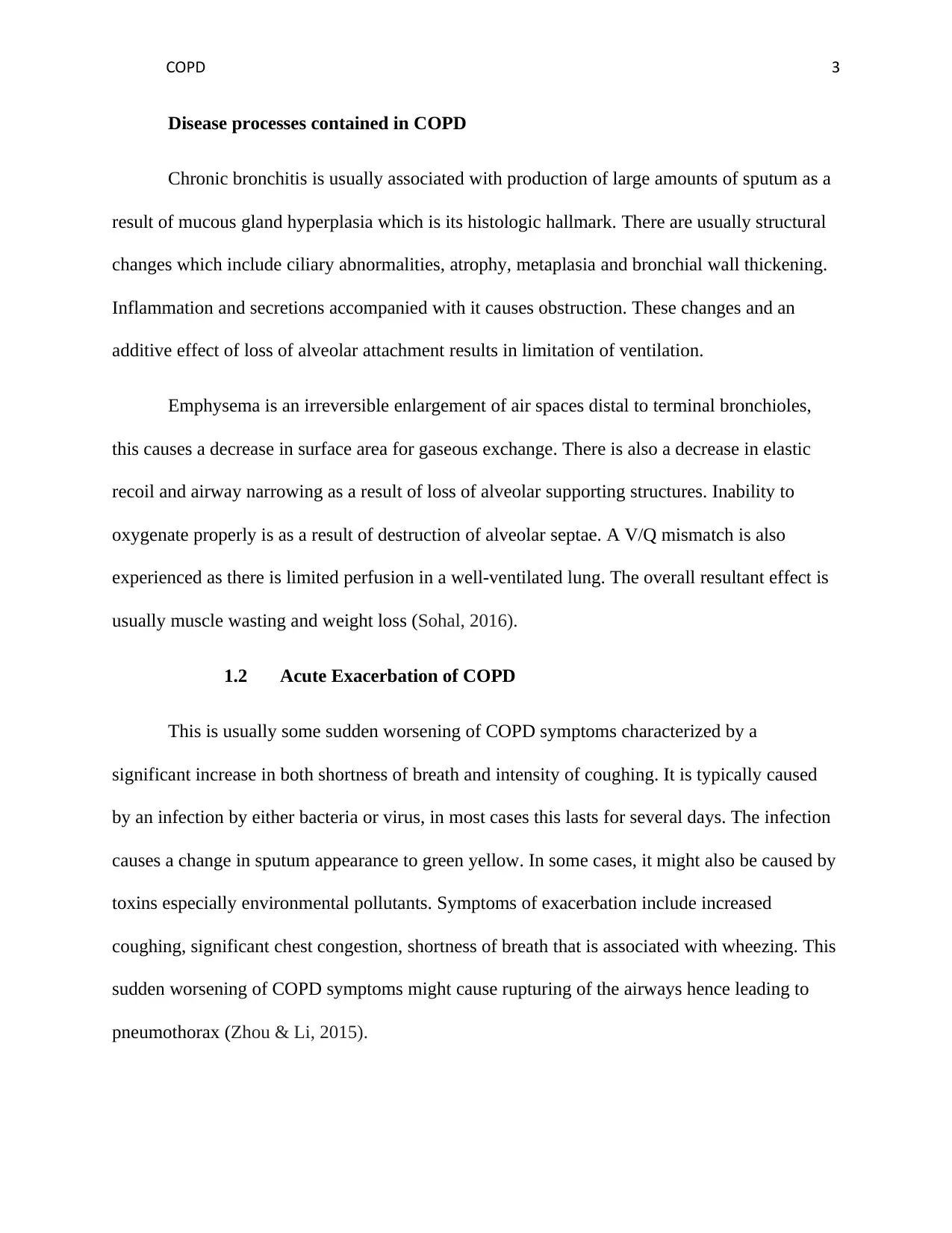
COPD 3
Disease processes contained in COPD
Chronic bronchitis is usually associated with production of large amounts of sputum as a
result of mucous gland hyperplasia which is its histologic hallmark. There are usually structural
changes which include ciliary abnormalities, atrophy, metaplasia and bronchial wall thickening.
Inflammation and secretions accompanied with it causes obstruction. These changes and an
additive effect of loss of alveolar attachment results in limitation of ventilation.
Emphysema is an irreversible enlargement of air spaces distal to terminal bronchioles,
this causes a decrease in surface area for gaseous exchange. There is also a decrease in elastic
recoil and airway narrowing as a result of loss of alveolar supporting structures. Inability to
oxygenate properly is as a result of destruction of alveolar septae. A V/Q mismatch is also
experienced as there is limited perfusion in a well-ventilated lung. The overall resultant effect is
usually muscle wasting and weight loss (Sohal, 2016).
1.2 Acute Exacerbation of COPD
This is usually some sudden worsening of COPD symptoms characterized by a
significant increase in both shortness of breath and intensity of coughing. It is typically caused
by an infection by either bacteria or virus, in most cases this lasts for several days. The infection
causes a change in sputum appearance to green yellow. In some cases, it might also be caused by
toxins especially environmental pollutants. Symptoms of exacerbation include increased
coughing, significant chest congestion, shortness of breath that is associated with wheezing. This
sudden worsening of COPD symptoms might cause rupturing of the airways hence leading to
pneumothorax (Zhou & Li, 2015).
Disease processes contained in COPD
Chronic bronchitis is usually associated with production of large amounts of sputum as a
result of mucous gland hyperplasia which is its histologic hallmark. There are usually structural
changes which include ciliary abnormalities, atrophy, metaplasia and bronchial wall thickening.
Inflammation and secretions accompanied with it causes obstruction. These changes and an
additive effect of loss of alveolar attachment results in limitation of ventilation.
Emphysema is an irreversible enlargement of air spaces distal to terminal bronchioles,
this causes a decrease in surface area for gaseous exchange. There is also a decrease in elastic
recoil and airway narrowing as a result of loss of alveolar supporting structures. Inability to
oxygenate properly is as a result of destruction of alveolar septae. A V/Q mismatch is also
experienced as there is limited perfusion in a well-ventilated lung. The overall resultant effect is
usually muscle wasting and weight loss (Sohal, 2016).
1.2 Acute Exacerbation of COPD
This is usually some sudden worsening of COPD symptoms characterized by a
significant increase in both shortness of breath and intensity of coughing. It is typically caused
by an infection by either bacteria or virus, in most cases this lasts for several days. The infection
causes a change in sputum appearance to green yellow. In some cases, it might also be caused by
toxins especially environmental pollutants. Symptoms of exacerbation include increased
coughing, significant chest congestion, shortness of breath that is associated with wheezing. This
sudden worsening of COPD symptoms might cause rupturing of the airways hence leading to
pneumothorax (Zhou & Li, 2015).
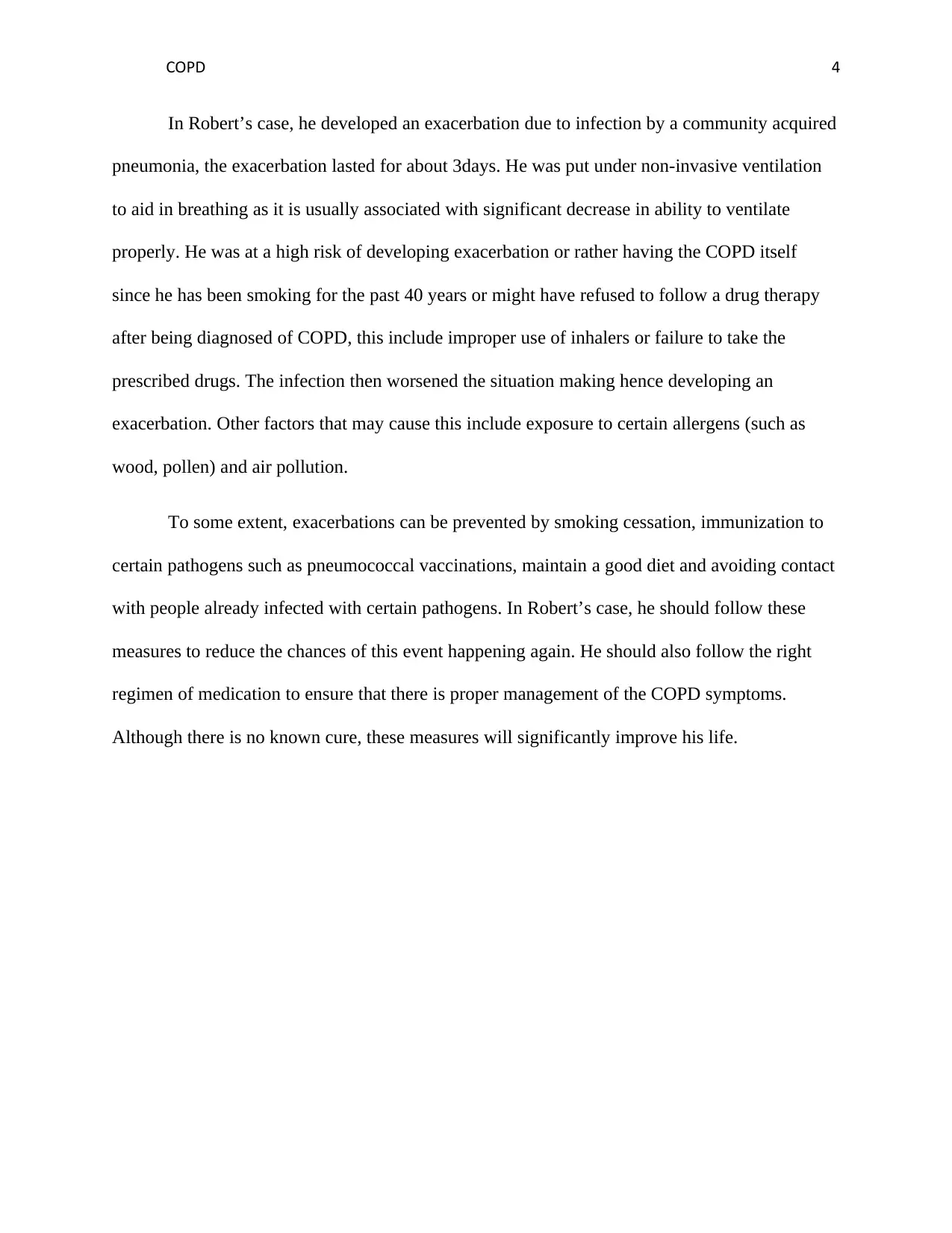
COPD 4
In Robert’s case, he developed an exacerbation due to infection by a community acquired
pneumonia, the exacerbation lasted for about 3days. He was put under non-invasive ventilation
to aid in breathing as it is usually associated with significant decrease in ability to ventilate
properly. He was at a high risk of developing exacerbation or rather having the COPD itself
since he has been smoking for the past 40 years or might have refused to follow a drug therapy
after being diagnosed of COPD, this include improper use of inhalers or failure to take the
prescribed drugs. The infection then worsened the situation making hence developing an
exacerbation. Other factors that may cause this include exposure to certain allergens (such as
wood, pollen) and air pollution.
To some extent, exacerbations can be prevented by smoking cessation, immunization to
certain pathogens such as pneumococcal vaccinations, maintain a good diet and avoiding contact
with people already infected with certain pathogens. In Robert’s case, he should follow these
measures to reduce the chances of this event happening again. He should also follow the right
regimen of medication to ensure that there is proper management of the COPD symptoms.
Although there is no known cure, these measures will significantly improve his life.
In Robert’s case, he developed an exacerbation due to infection by a community acquired
pneumonia, the exacerbation lasted for about 3days. He was put under non-invasive ventilation
to aid in breathing as it is usually associated with significant decrease in ability to ventilate
properly. He was at a high risk of developing exacerbation or rather having the COPD itself
since he has been smoking for the past 40 years or might have refused to follow a drug therapy
after being diagnosed of COPD, this include improper use of inhalers or failure to take the
prescribed drugs. The infection then worsened the situation making hence developing an
exacerbation. Other factors that may cause this include exposure to certain allergens (such as
wood, pollen) and air pollution.
To some extent, exacerbations can be prevented by smoking cessation, immunization to
certain pathogens such as pneumococcal vaccinations, maintain a good diet and avoiding contact
with people already infected with certain pathogens. In Robert’s case, he should follow these
measures to reduce the chances of this event happening again. He should also follow the right
regimen of medication to ensure that there is proper management of the COPD symptoms.
Although there is no known cure, these measures will significantly improve his life.
Secure Best Marks with AI Grader
Need help grading? Try our AI Grader for instant feedback on your assignments.
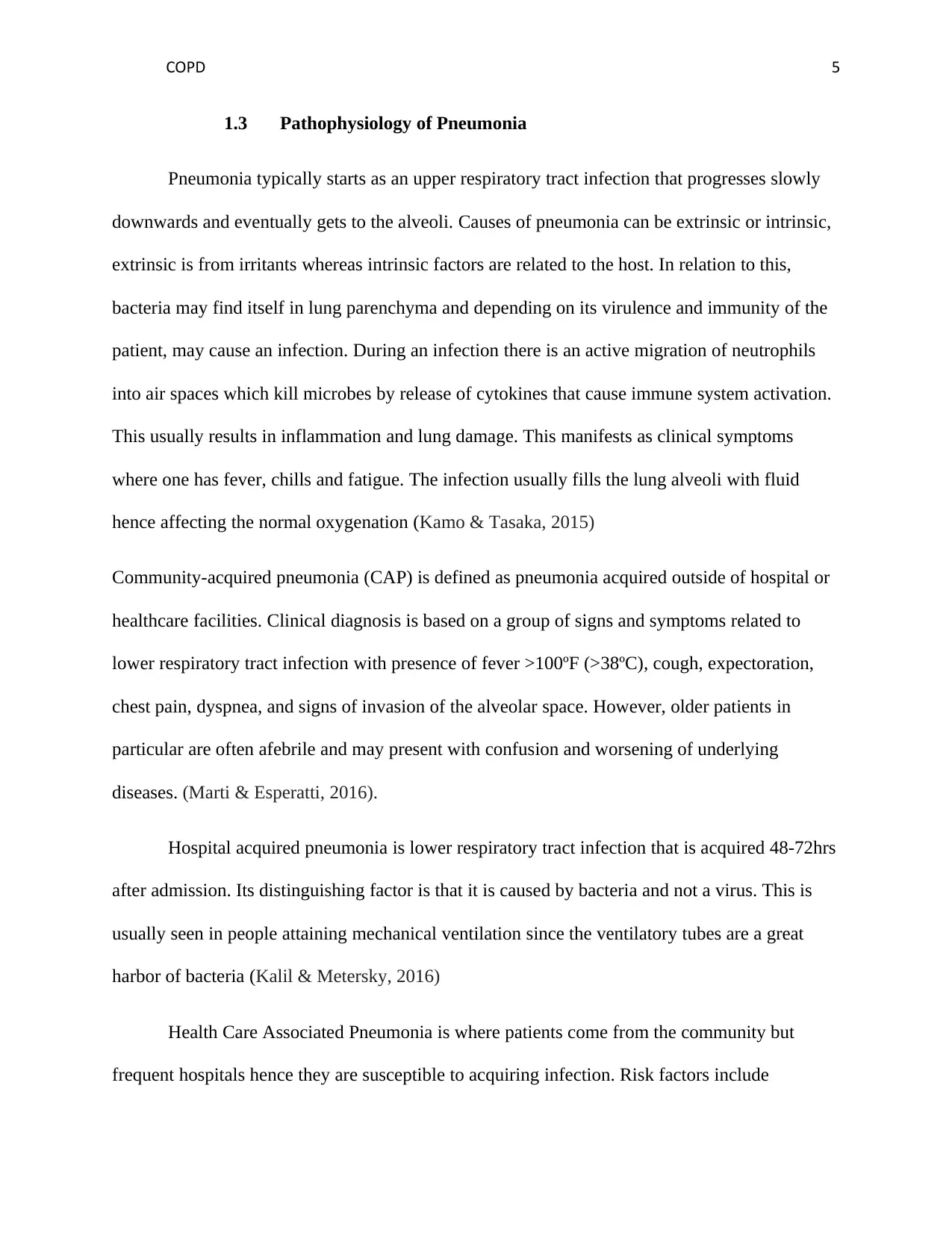
COPD 5
1.3 Pathophysiology of Pneumonia
Pneumonia typically starts as an upper respiratory tract infection that progresses slowly
downwards and eventually gets to the alveoli. Causes of pneumonia can be extrinsic or intrinsic,
extrinsic is from irritants whereas intrinsic factors are related to the host. In relation to this,
bacteria may find itself in lung parenchyma and depending on its virulence and immunity of the
patient, may cause an infection. During an infection there is an active migration of neutrophils
into air spaces which kill microbes by release of cytokines that cause immune system activation.
This usually results in inflammation and lung damage. This manifests as clinical symptoms
where one has fever, chills and fatigue. The infection usually fills the lung alveoli with fluid
hence affecting the normal oxygenation (Kamo & Tasaka, 2015)
Community-acquired pneumonia (CAP) is defined as pneumonia acquired outside of hospital or
healthcare facilities. Clinical diagnosis is based on a group of signs and symptoms related to
lower respiratory tract infection with presence of fever >100ºF (>38ºC), cough, expectoration,
chest pain, dyspnea, and signs of invasion of the alveolar space. However, older patients in
particular are often afebrile and may present with confusion and worsening of underlying
diseases. (Marti & Esperatti, 2016).
Hospital acquired pneumonia is lower respiratory tract infection that is acquired 48-72hrs
after admission. Its distinguishing factor is that it is caused by bacteria and not a virus. This is
usually seen in people attaining mechanical ventilation since the ventilatory tubes are a great
harbor of bacteria (Kalil & Metersky, 2016)
Health Care Associated Pneumonia is where patients come from the community but
frequent hospitals hence they are susceptible to acquiring infection. Risk factors include
1.3 Pathophysiology of Pneumonia
Pneumonia typically starts as an upper respiratory tract infection that progresses slowly
downwards and eventually gets to the alveoli. Causes of pneumonia can be extrinsic or intrinsic,
extrinsic is from irritants whereas intrinsic factors are related to the host. In relation to this,
bacteria may find itself in lung parenchyma and depending on its virulence and immunity of the
patient, may cause an infection. During an infection there is an active migration of neutrophils
into air spaces which kill microbes by release of cytokines that cause immune system activation.
This usually results in inflammation and lung damage. This manifests as clinical symptoms
where one has fever, chills and fatigue. The infection usually fills the lung alveoli with fluid
hence affecting the normal oxygenation (Kamo & Tasaka, 2015)
Community-acquired pneumonia (CAP) is defined as pneumonia acquired outside of hospital or
healthcare facilities. Clinical diagnosis is based on a group of signs and symptoms related to
lower respiratory tract infection with presence of fever >100ºF (>38ºC), cough, expectoration,
chest pain, dyspnea, and signs of invasion of the alveolar space. However, older patients in
particular are often afebrile and may present with confusion and worsening of underlying
diseases. (Marti & Esperatti, 2016).
Hospital acquired pneumonia is lower respiratory tract infection that is acquired 48-72hrs
after admission. Its distinguishing factor is that it is caused by bacteria and not a virus. This is
usually seen in people attaining mechanical ventilation since the ventilatory tubes are a great
harbor of bacteria (Kalil & Metersky, 2016)
Health Care Associated Pneumonia is where patients come from the community but
frequent hospitals hence they are susceptible to acquiring infection. Risk factors include
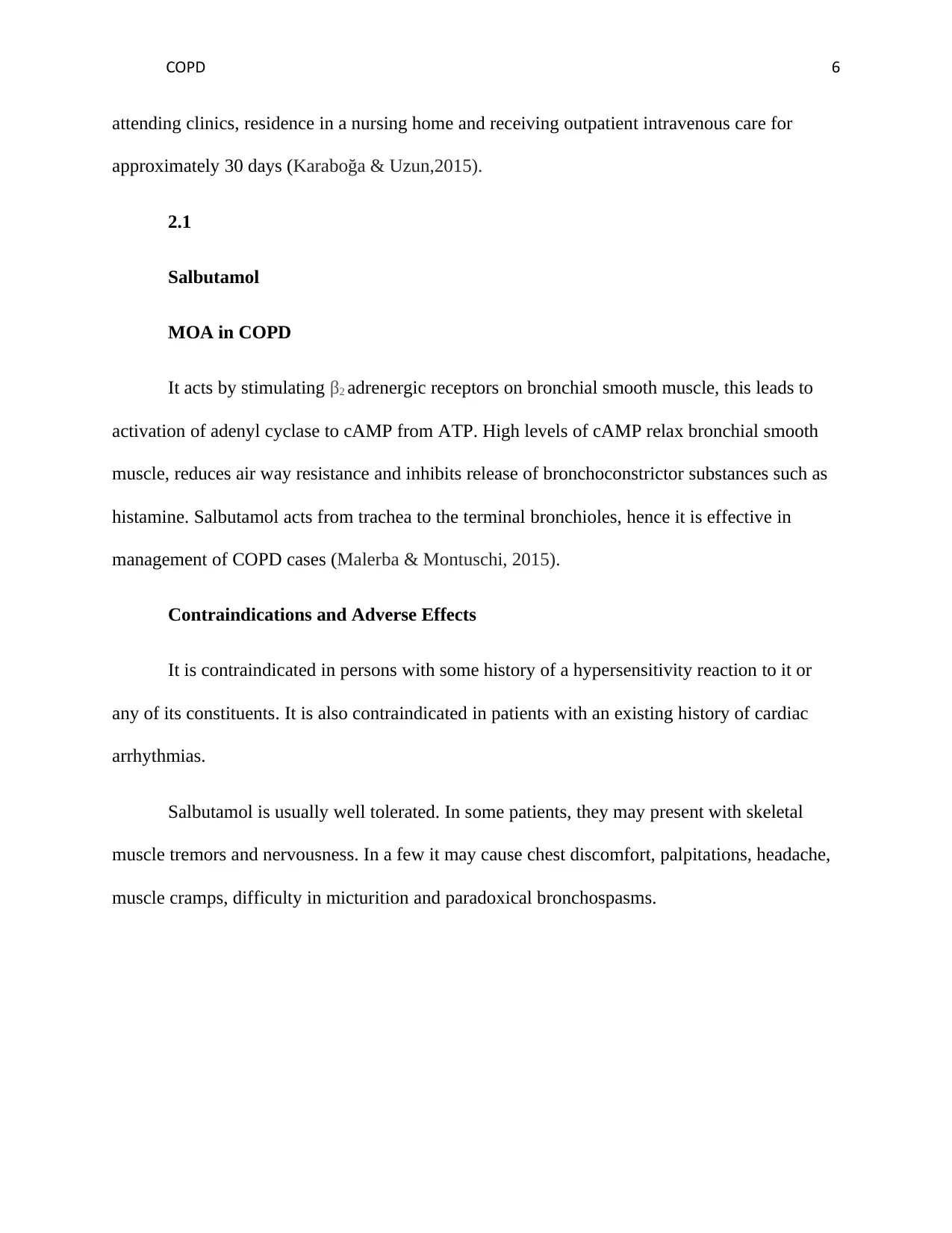
COPD 6
attending clinics, residence in a nursing home and receiving outpatient intravenous care for
approximately 30 days (Karaboğa & Uzun,2015).
2.1
Salbutamol
MOA in COPD
It acts by stimulating β2 adrenergic receptors on bronchial smooth muscle, this leads to
activation of adenyl cyclase to cAMP from ATP. High levels of cAMP relax bronchial smooth
muscle, reduces air way resistance and inhibits release of bronchoconstrictor substances such as
histamine. Salbutamol acts from trachea to the terminal bronchioles, hence it is effective in
management of COPD cases (Malerba & Montuschi, 2015).
Contraindications and Adverse Effects
It is contraindicated in persons with some history of a hypersensitivity reaction to it or
any of its constituents. It is also contraindicated in patients with an existing history of cardiac
arrhythmias.
Salbutamol is usually well tolerated. In some patients, they may present with skeletal
muscle tremors and nervousness. In a few it may cause chest discomfort, palpitations, headache,
muscle cramps, difficulty in micturition and paradoxical bronchospasms.
attending clinics, residence in a nursing home and receiving outpatient intravenous care for
approximately 30 days (Karaboğa & Uzun,2015).
2.1
Salbutamol
MOA in COPD
It acts by stimulating β2 adrenergic receptors on bronchial smooth muscle, this leads to
activation of adenyl cyclase to cAMP from ATP. High levels of cAMP relax bronchial smooth
muscle, reduces air way resistance and inhibits release of bronchoconstrictor substances such as
histamine. Salbutamol acts from trachea to the terminal bronchioles, hence it is effective in
management of COPD cases (Malerba & Montuschi, 2015).
Contraindications and Adverse Effects
It is contraindicated in persons with some history of a hypersensitivity reaction to it or
any of its constituents. It is also contraindicated in patients with an existing history of cardiac
arrhythmias.
Salbutamol is usually well tolerated. In some patients, they may present with skeletal
muscle tremors and nervousness. In a few it may cause chest discomfort, palpitations, headache,
muscle cramps, difficulty in micturition and paradoxical bronchospasms.
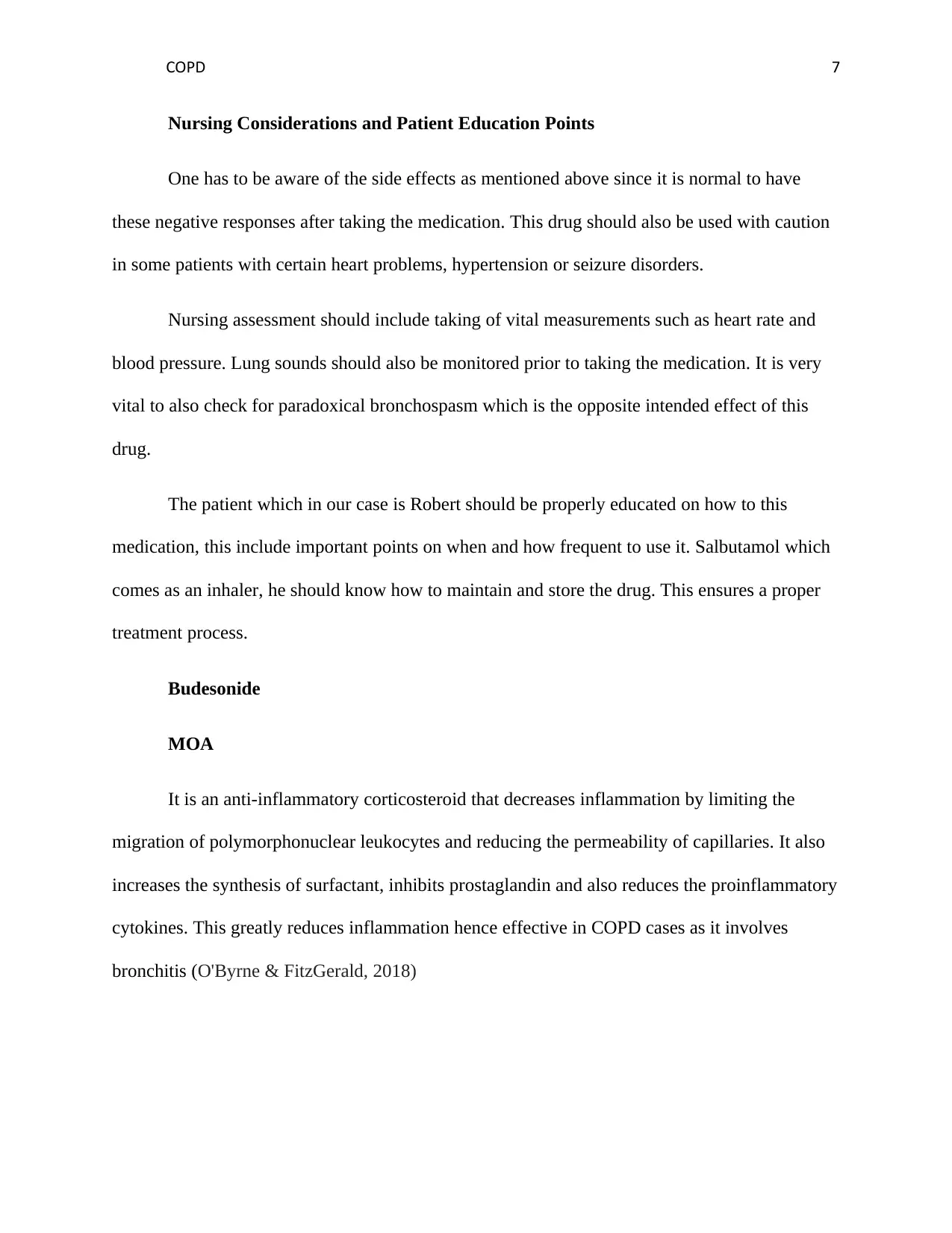
COPD 7
Nursing Considerations and Patient Education Points
One has to be aware of the side effects as mentioned above since it is normal to have
these negative responses after taking the medication. This drug should also be used with caution
in some patients with certain heart problems, hypertension or seizure disorders.
Nursing assessment should include taking of vital measurements such as heart rate and
blood pressure. Lung sounds should also be monitored prior to taking the medication. It is very
vital to also check for paradoxical bronchospasm which is the opposite intended effect of this
drug.
The patient which in our case is Robert should be properly educated on how to this
medication, this include important points on when and how frequent to use it. Salbutamol which
comes as an inhaler, he should know how to maintain and store the drug. This ensures a proper
treatment process.
Budesonide
MOA
It is an anti-inflammatory corticosteroid that decreases inflammation by limiting the
migration of polymorphonuclear leukocytes and reducing the permeability of capillaries. It also
increases the synthesis of surfactant, inhibits prostaglandin and also reduces the proinflammatory
cytokines. This greatly reduces inflammation hence effective in COPD cases as it involves
bronchitis (O'Byrne & FitzGerald, 2018)
Nursing Considerations and Patient Education Points
One has to be aware of the side effects as mentioned above since it is normal to have
these negative responses after taking the medication. This drug should also be used with caution
in some patients with certain heart problems, hypertension or seizure disorders.
Nursing assessment should include taking of vital measurements such as heart rate and
blood pressure. Lung sounds should also be monitored prior to taking the medication. It is very
vital to also check for paradoxical bronchospasm which is the opposite intended effect of this
drug.
The patient which in our case is Robert should be properly educated on how to this
medication, this include important points on when and how frequent to use it. Salbutamol which
comes as an inhaler, he should know how to maintain and store the drug. This ensures a proper
treatment process.
Budesonide
MOA
It is an anti-inflammatory corticosteroid that decreases inflammation by limiting the
migration of polymorphonuclear leukocytes and reducing the permeability of capillaries. It also
increases the synthesis of surfactant, inhibits prostaglandin and also reduces the proinflammatory
cytokines. This greatly reduces inflammation hence effective in COPD cases as it involves
bronchitis (O'Byrne & FitzGerald, 2018)
Paraphrase This Document
Need a fresh take? Get an instant paraphrase of this document with our AI Paraphraser
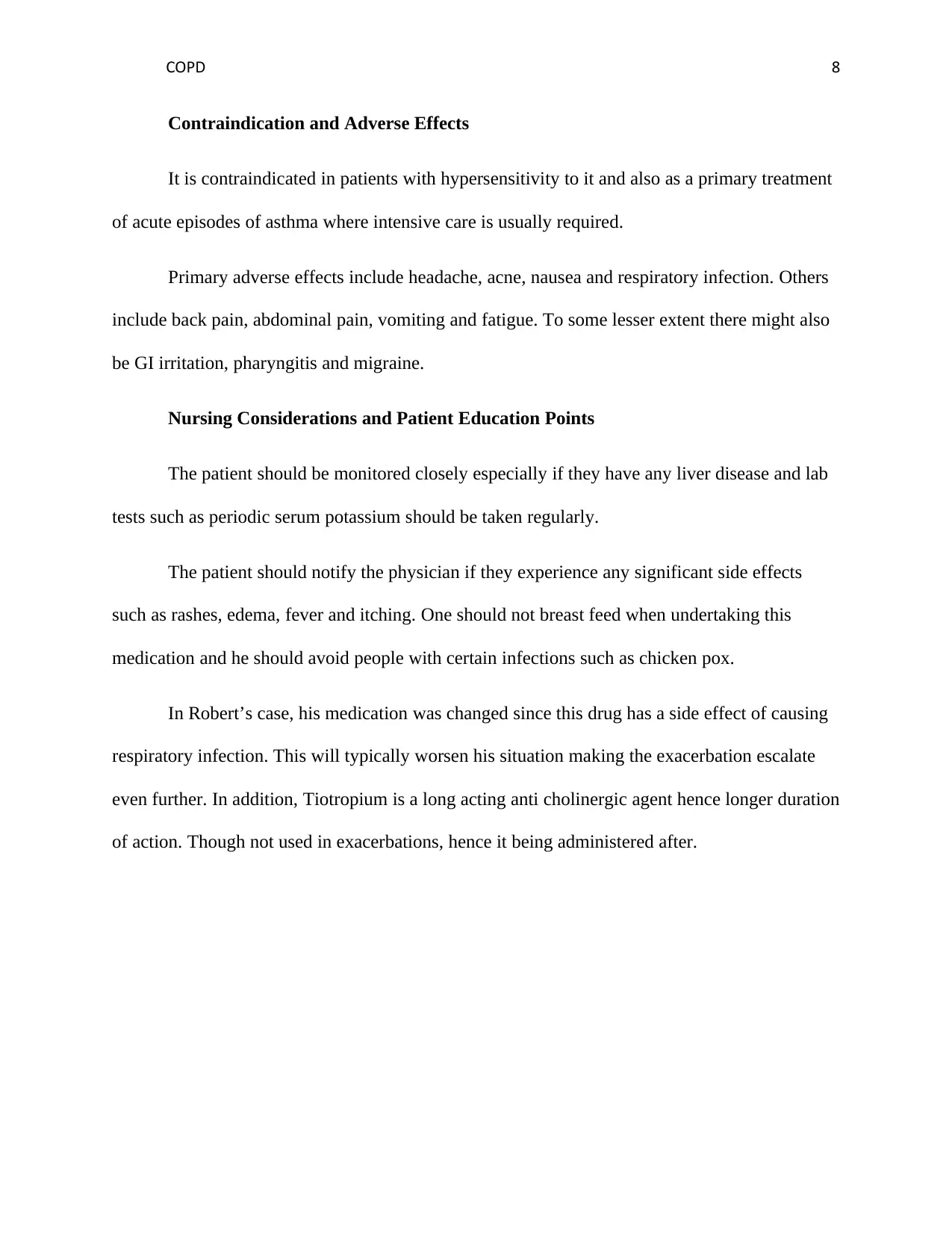
COPD 8
Contraindication and Adverse Effects
It is contraindicated in patients with hypersensitivity to it and also as a primary treatment
of acute episodes of asthma where intensive care is usually required.
Primary adverse effects include headache, acne, nausea and respiratory infection. Others
include back pain, abdominal pain, vomiting and fatigue. To some lesser extent there might also
be GI irritation, pharyngitis and migraine.
Nursing Considerations and Patient Education Points
The patient should be monitored closely especially if they have any liver disease and lab
tests such as periodic serum potassium should be taken regularly.
The patient should notify the physician if they experience any significant side effects
such as rashes, edema, fever and itching. One should not breast feed when undertaking this
medication and he should avoid people with certain infections such as chicken pox.
In Robert’s case, his medication was changed since this drug has a side effect of causing
respiratory infection. This will typically worsen his situation making the exacerbation escalate
even further. In addition, Tiotropium is a long acting anti cholinergic agent hence longer duration
of action. Though not used in exacerbations, hence it being administered after.
Contraindication and Adverse Effects
It is contraindicated in patients with hypersensitivity to it and also as a primary treatment
of acute episodes of asthma where intensive care is usually required.
Primary adverse effects include headache, acne, nausea and respiratory infection. Others
include back pain, abdominal pain, vomiting and fatigue. To some lesser extent there might also
be GI irritation, pharyngitis and migraine.
Nursing Considerations and Patient Education Points
The patient should be monitored closely especially if they have any liver disease and lab
tests such as periodic serum potassium should be taken regularly.
The patient should notify the physician if they experience any significant side effects
such as rashes, edema, fever and itching. One should not breast feed when undertaking this
medication and he should avoid people with certain infections such as chicken pox.
In Robert’s case, his medication was changed since this drug has a side effect of causing
respiratory infection. This will typically worsen his situation making the exacerbation escalate
even further. In addition, Tiotropium is a long acting anti cholinergic agent hence longer duration
of action. Though not used in exacerbations, hence it being administered after.

COPD 9
Tiotropium
MOA
Long-acting ant muscarinic agent, often referred to as anticholinergic
Inhibits M3-receptors at smooth muscle, leading to bronchodilation
Adverse effects and Contraindications
Primary adverse effects include upper respiratory tract infection, dry mouth and sinusitis.
Others include abdominal pain, chest pain, constipation and depression.
Should not be used with umeclidinium bromide since it causes pharmacodynamic
synergism leading to toxicity.
Nursing Considerations and Patient Education Points
Drug should be withdrawn if angioedema occurs and anticholinergic effects should be
monitored closely (urinary retention and tachycardia).
The patient should notify the physician if he experiences edema, constipation, blurred
vision or urinary difficulties. He should not allow powdered medication to contact the eyes since
it might cause blurred vision. He should also report if he experiences anything that might not feel
normal.
Tiotropium
MOA
Long-acting ant muscarinic agent, often referred to as anticholinergic
Inhibits M3-receptors at smooth muscle, leading to bronchodilation
Adverse effects and Contraindications
Primary adverse effects include upper respiratory tract infection, dry mouth and sinusitis.
Others include abdominal pain, chest pain, constipation and depression.
Should not be used with umeclidinium bromide since it causes pharmacodynamic
synergism leading to toxicity.
Nursing Considerations and Patient Education Points
Drug should be withdrawn if angioedema occurs and anticholinergic effects should be
monitored closely (urinary retention and tachycardia).
The patient should notify the physician if he experiences edema, constipation, blurred
vision or urinary difficulties. He should not allow powdered medication to contact the eyes since
it might cause blurred vision. He should also report if he experiences anything that might not feel
normal.

COPD 10
2.2 Antibiotics used in treatment of streptococcus penumoniae
Cefotaxime
MOA
Binds to penicillin-binding proteins and inhibits final transpeptidation step of
peptidoglycan synthesis, resulting in cell-wall death; resists degradation by beta-lactamase;
proper dosing and appropriate route of administration are determined by condition of patient,
severity of infection, and susceptibility of microorganism
Contraindications and Adverse Effects
Contraindicated in patients with a known hypersensitivity to it or other cephalosporins
AE’s include diarrhea, colitis, nausea, pain at injection site, rash, thrombocytopenia,
fever and vomiting.
Nursing Considerations and Patient Education Points
There should be an assessment to determine hypersensitivity reactions to penicillin’s and
cephalosporins before initiation of the treatment. Culture and sensitivity tests should also be
carried out during treatment. In prolonged treatment, super infection with other organisms may
occur hence this should also be closely monitored. In case there is diarrhea, it should be reported
promptly.
2.2 Antibiotics used in treatment of streptococcus penumoniae
Cefotaxime
MOA
Binds to penicillin-binding proteins and inhibits final transpeptidation step of
peptidoglycan synthesis, resulting in cell-wall death; resists degradation by beta-lactamase;
proper dosing and appropriate route of administration are determined by condition of patient,
severity of infection, and susceptibility of microorganism
Contraindications and Adverse Effects
Contraindicated in patients with a known hypersensitivity to it or other cephalosporins
AE’s include diarrhea, colitis, nausea, pain at injection site, rash, thrombocytopenia,
fever and vomiting.
Nursing Considerations and Patient Education Points
There should be an assessment to determine hypersensitivity reactions to penicillin’s and
cephalosporins before initiation of the treatment. Culture and sensitivity tests should also be
carried out during treatment. In prolonged treatment, super infection with other organisms may
occur hence this should also be closely monitored. In case there is diarrhea, it should be reported
promptly.
Secure Best Marks with AI Grader
Need help grading? Try our AI Grader for instant feedback on your assignments.
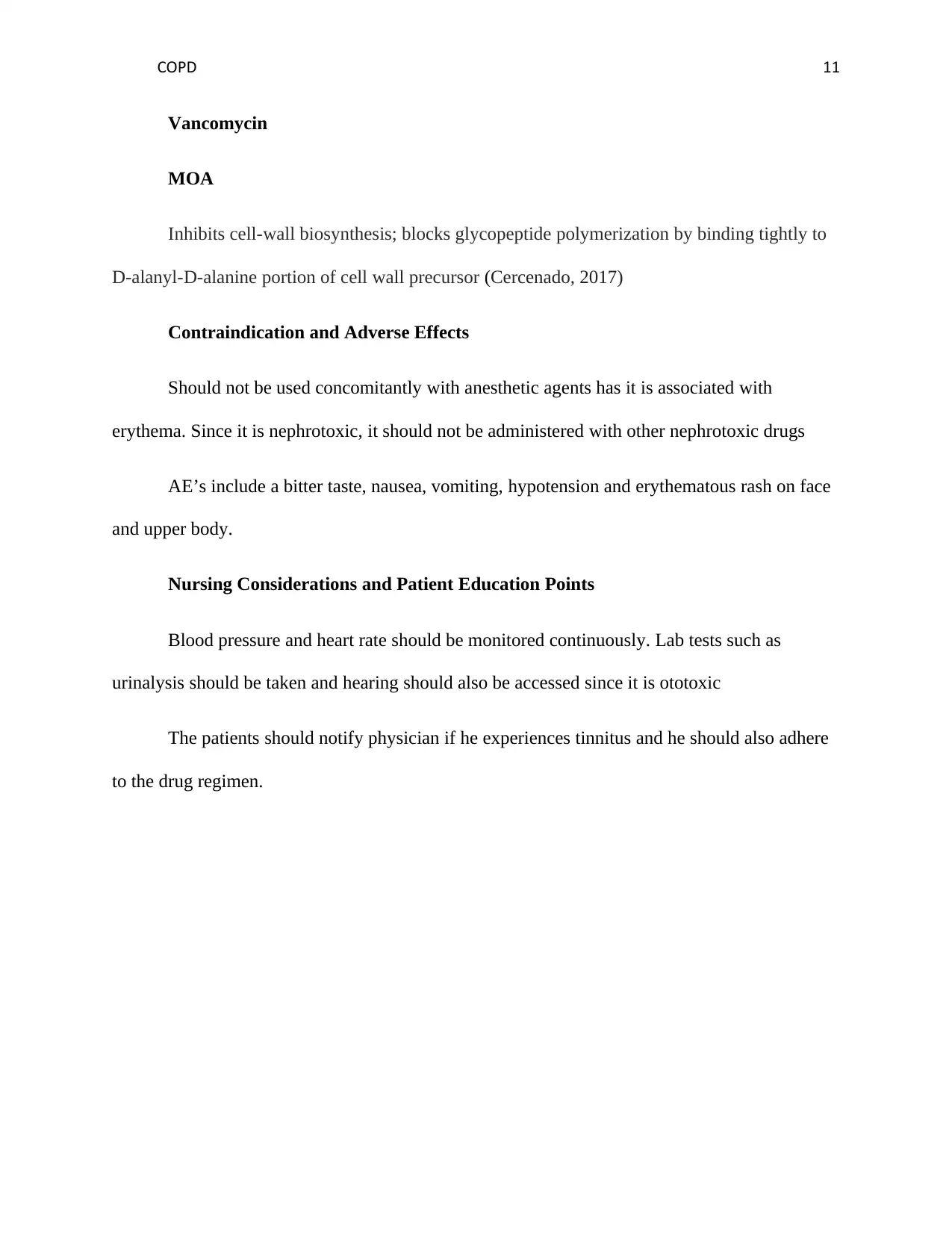
COPD 11
Vancomycin
MOA
Inhibits cell-wall biosynthesis; blocks glycopeptide polymerization by binding tightly to
D-alanyl-D-alanine portion of cell wall precursor (Cercenado, 2017)
Contraindication and Adverse Effects
Should not be used concomitantly with anesthetic agents has it is associated with
erythema. Since it is nephrotoxic, it should not be administered with other nephrotoxic drugs
AE’s include a bitter taste, nausea, vomiting, hypotension and erythematous rash on face
and upper body.
Nursing Considerations and Patient Education Points
Blood pressure and heart rate should be monitored continuously. Lab tests such as
urinalysis should be taken and hearing should also be accessed since it is ototoxic
The patients should notify physician if he experiences tinnitus and he should also adhere
to the drug regimen.
Vancomycin
MOA
Inhibits cell-wall biosynthesis; blocks glycopeptide polymerization by binding tightly to
D-alanyl-D-alanine portion of cell wall precursor (Cercenado, 2017)
Contraindication and Adverse Effects
Should not be used concomitantly with anesthetic agents has it is associated with
erythema. Since it is nephrotoxic, it should not be administered with other nephrotoxic drugs
AE’s include a bitter taste, nausea, vomiting, hypotension and erythematous rash on face
and upper body.
Nursing Considerations and Patient Education Points
Blood pressure and heart rate should be monitored continuously. Lab tests such as
urinalysis should be taken and hearing should also be accessed since it is ototoxic
The patients should notify physician if he experiences tinnitus and he should also adhere
to the drug regimen.
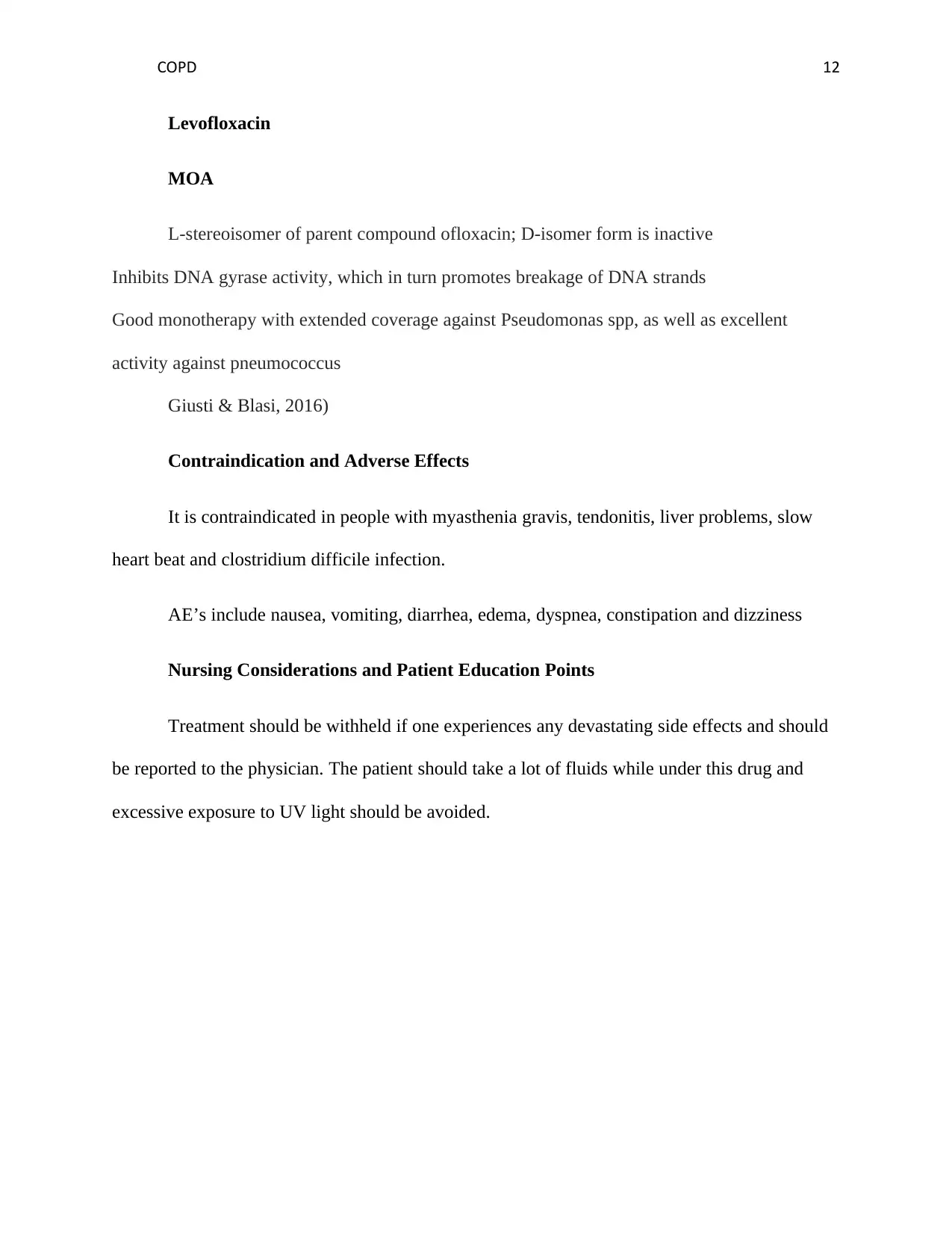
COPD 12
Levofloxacin
MOA
L-stereoisomer of parent compound ofloxacin; D-isomer form is inactive
Inhibits DNA gyrase activity, which in turn promotes breakage of DNA strands
Good monotherapy with extended coverage against Pseudomonas spp, as well as excellent
activity against pneumococcus
Giusti & Blasi, 2016)
Contraindication and Adverse Effects
It is contraindicated in people with myasthenia gravis, tendonitis, liver problems, slow
heart beat and clostridium difficile infection.
AE’s include nausea, vomiting, diarrhea, edema, dyspnea, constipation and dizziness
Nursing Considerations and Patient Education Points
Treatment should be withheld if one experiences any devastating side effects and should
be reported to the physician. The patient should take a lot of fluids while under this drug and
excessive exposure to UV light should be avoided.
Levofloxacin
MOA
L-stereoisomer of parent compound ofloxacin; D-isomer form is inactive
Inhibits DNA gyrase activity, which in turn promotes breakage of DNA strands
Good monotherapy with extended coverage against Pseudomonas spp, as well as excellent
activity against pneumococcus
Giusti & Blasi, 2016)
Contraindication and Adverse Effects
It is contraindicated in people with myasthenia gravis, tendonitis, liver problems, slow
heart beat and clostridium difficile infection.
AE’s include nausea, vomiting, diarrhea, edema, dyspnea, constipation and dizziness
Nursing Considerations and Patient Education Points
Treatment should be withheld if one experiences any devastating side effects and should
be reported to the physician. The patient should take a lot of fluids while under this drug and
excessive exposure to UV light should be avoided.
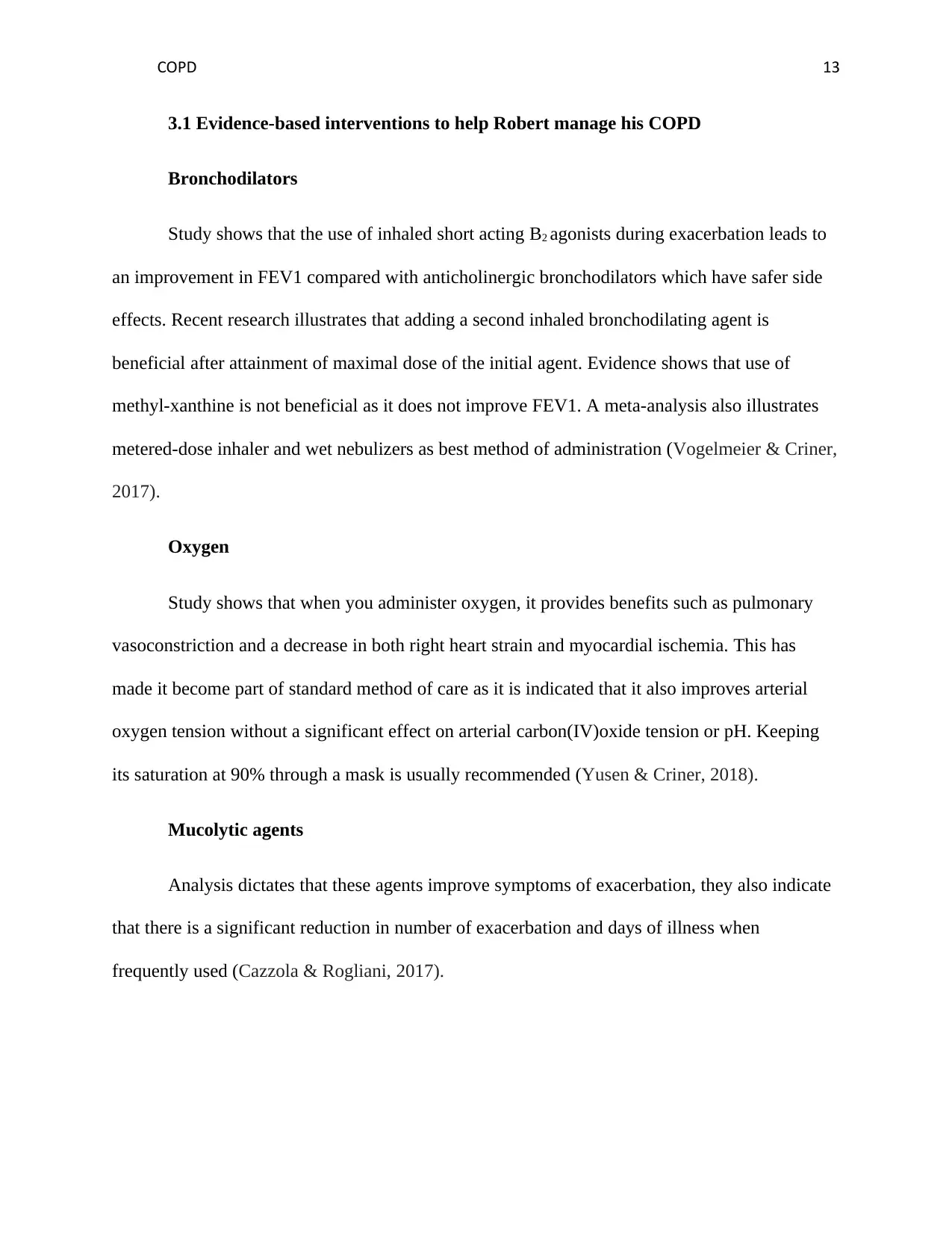
COPD 13
3.1 Evidence-based interventions to help Robert manage his COPD
Bronchodilators
Study shows that the use of inhaled short acting B2 agonists during exacerbation leads to
an improvement in FEV1 compared with anticholinergic bronchodilators which have safer side
effects. Recent research illustrates that adding a second inhaled bronchodilating agent is
beneficial after attainment of maximal dose of the initial agent. Evidence shows that use of
methyl-xanthine is not beneficial as it does not improve FEV1. A meta-analysis also illustrates
metered-dose inhaler and wet nebulizers as best method of administration (Vogelmeier & Criner,
2017).
Oxygen
Study shows that when you administer oxygen, it provides benefits such as pulmonary
vasoconstriction and a decrease in both right heart strain and myocardial ischemia. This has
made it become part of standard method of care as it is indicated that it also improves arterial
oxygen tension without a significant effect on arterial carbon(IV)oxide tension or pH. Keeping
its saturation at 90% through a mask is usually recommended (Yusen & Criner, 2018).
Mucolytic agents
Analysis dictates that these agents improve symptoms of exacerbation, they also indicate
that there is a significant reduction in number of exacerbation and days of illness when
frequently used (Cazzola & Rogliani, 2017).
3.1 Evidence-based interventions to help Robert manage his COPD
Bronchodilators
Study shows that the use of inhaled short acting B2 agonists during exacerbation leads to
an improvement in FEV1 compared with anticholinergic bronchodilators which have safer side
effects. Recent research illustrates that adding a second inhaled bronchodilating agent is
beneficial after attainment of maximal dose of the initial agent. Evidence shows that use of
methyl-xanthine is not beneficial as it does not improve FEV1. A meta-analysis also illustrates
metered-dose inhaler and wet nebulizers as best method of administration (Vogelmeier & Criner,
2017).
Oxygen
Study shows that when you administer oxygen, it provides benefits such as pulmonary
vasoconstriction and a decrease in both right heart strain and myocardial ischemia. This has
made it become part of standard method of care as it is indicated that it also improves arterial
oxygen tension without a significant effect on arterial carbon(IV)oxide tension or pH. Keeping
its saturation at 90% through a mask is usually recommended (Yusen & Criner, 2018).
Mucolytic agents
Analysis dictates that these agents improve symptoms of exacerbation, they also indicate
that there is a significant reduction in number of exacerbation and days of illness when
frequently used (Cazzola & Rogliani, 2017).
Paraphrase This Document
Need a fresh take? Get an instant paraphrase of this document with our AI Paraphraser

COPD 14
References
Cazzola, M., Rogliani, P., Calzetta, L., Hanania, N. A., & Matera, M. G. (2017). Impact of
mucolytic agents on COPD exacerbations: a pair-wise and network meta-
analysis. COPD: Journal of Chronic Obstructive Pulmonary Disease, 14(5), 552-563.
Cercenado, E. (2017). Antimicrobial spectrum of dalbavancin. Mechanism of action and in vitro
activity against Gram-positive microorganisms. Enfermedades infecciosas y
microbiologia clinica, 35, 9-14.
Giusti, M., Blasi, F., Iori, I., Mazzone, A., Sgambato, F., Politi, C., ... & Bonizzoni, E. (2016).
Prulifloxacin vs Levofloxacin for exacerbation of COPD after failure of other
antibiotics. COPD: Journal of Chronic Obstructive Pulmonary Disease, 13(5), 555-560.
Jenkins, C., Calverley, P. M., Carter, K., Tetzlaff, K., de la Hoz, A., Anzueto, A., ... &
Wedzicha, J. A. (2018). Tiotropium/Olodaterol Versus Tiotropium in the Prevention of
Exacerbations of Chronic Obstructive Pulmonary Disease: Impact of Adjusting for
Baseline Characteristics. In A75. COPD: TARGETS, MODELS, AND CLINICAL
STUDIES (pp. A2387-A2387). American Thoracic Society.
Kalil, A. C., Metersky, M. L., Klompas, M., Muscedere, J., Sweeney, D. A., Palmer, L. B., ... &
El Solh, A. A. (2016). Management of adults with hospital-acquired and ventilator-
associated pneumonia: 2016 clinical practice guidelines by the Infectious Diseases
Society of America and the American Thoracic Society. Clinical Infectious
Diseases, 63(5), e61-e111.
Kamo, T., & Tasaka, S. (2015). Pathophysiology and diagnosis of severe pneumonia and acute
respiratory distress syndrome. Japanese Journal of Chest Diseases, 74(5), 500-510.
References
Cazzola, M., Rogliani, P., Calzetta, L., Hanania, N. A., & Matera, M. G. (2017). Impact of
mucolytic agents on COPD exacerbations: a pair-wise and network meta-
analysis. COPD: Journal of Chronic Obstructive Pulmonary Disease, 14(5), 552-563.
Cercenado, E. (2017). Antimicrobial spectrum of dalbavancin. Mechanism of action and in vitro
activity against Gram-positive microorganisms. Enfermedades infecciosas y
microbiologia clinica, 35, 9-14.
Giusti, M., Blasi, F., Iori, I., Mazzone, A., Sgambato, F., Politi, C., ... & Bonizzoni, E. (2016).
Prulifloxacin vs Levofloxacin for exacerbation of COPD after failure of other
antibiotics. COPD: Journal of Chronic Obstructive Pulmonary Disease, 13(5), 555-560.
Jenkins, C., Calverley, P. M., Carter, K., Tetzlaff, K., de la Hoz, A., Anzueto, A., ... &
Wedzicha, J. A. (2018). Tiotropium/Olodaterol Versus Tiotropium in the Prevention of
Exacerbations of Chronic Obstructive Pulmonary Disease: Impact of Adjusting for
Baseline Characteristics. In A75. COPD: TARGETS, MODELS, AND CLINICAL
STUDIES (pp. A2387-A2387). American Thoracic Society.
Kalil, A. C., Metersky, M. L., Klompas, M., Muscedere, J., Sweeney, D. A., Palmer, L. B., ... &
El Solh, A. A. (2016). Management of adults with hospital-acquired and ventilator-
associated pneumonia: 2016 clinical practice guidelines by the Infectious Diseases
Society of America and the American Thoracic Society. Clinical Infectious
Diseases, 63(5), e61-e111.
Kamo, T., & Tasaka, S. (2015). Pathophysiology and diagnosis of severe pneumonia and acute
respiratory distress syndrome. Japanese Journal of Chest Diseases, 74(5), 500-510.
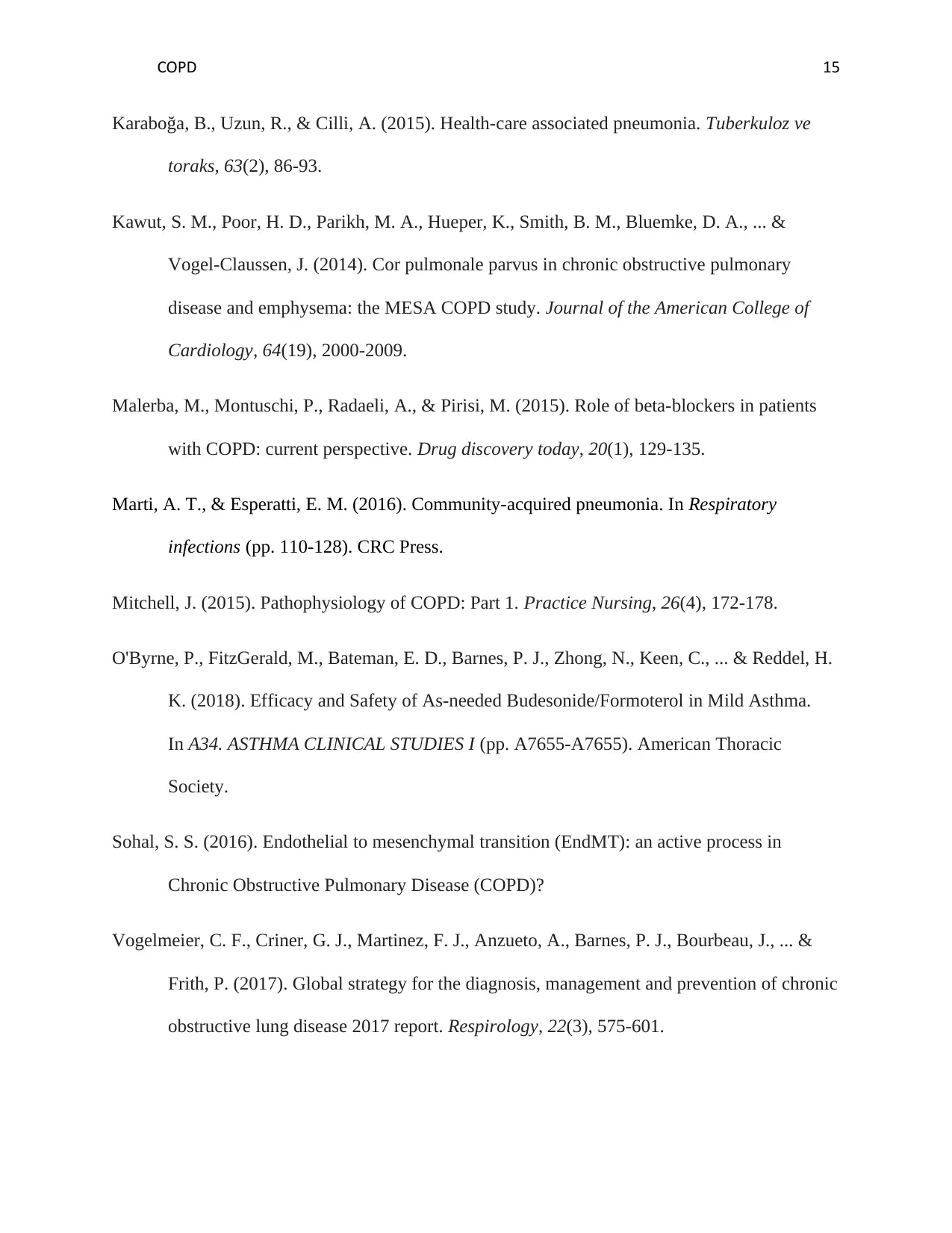
COPD 15
Karaboğa, B., Uzun, R., & Cilli, A. (2015). Health-care associated pneumonia. Tuberkuloz ve
toraks, 63(2), 86-93.
Kawut, S. M., Poor, H. D., Parikh, M. A., Hueper, K., Smith, B. M., Bluemke, D. A., ... &
Vogel-Claussen, J. (2014). Cor pulmonale parvus in chronic obstructive pulmonary
disease and emphysema: the MESA COPD study. Journal of the American College of
Cardiology, 64(19), 2000-2009.
Malerba, M., Montuschi, P., Radaeli, A., & Pirisi, M. (2015). Role of beta-blockers in patients
with COPD: current perspective. Drug discovery today, 20(1), 129-135.
Marti, A. T., & Esperatti, E. M. (2016). Community-acquired pneumonia. In Respiratory
infections (pp. 110-128). CRC Press.
Mitchell, J. (2015). Pathophysiology of COPD: Part 1. Practice Nursing, 26(4), 172-178.
O'Byrne, P., FitzGerald, M., Bateman, E. D., Barnes, P. J., Zhong, N., Keen, C., ... & Reddel, H.
K. (2018). Efficacy and Safety of As-needed Budesonide/Formoterol in Mild Asthma.
In A34. ASTHMA CLINICAL STUDIES I (pp. A7655-A7655). American Thoracic
Society.
Sohal, S. S. (2016). Endothelial to mesenchymal transition (EndMT): an active process in
Chronic Obstructive Pulmonary Disease (COPD)?
Vogelmeier, C. F., Criner, G. J., Martinez, F. J., Anzueto, A., Barnes, P. J., Bourbeau, J., ... &
Frith, P. (2017). Global strategy for the diagnosis, management and prevention of chronic
obstructive lung disease 2017 report. Respirology, 22(3), 575-601.
Karaboğa, B., Uzun, R., & Cilli, A. (2015). Health-care associated pneumonia. Tuberkuloz ve
toraks, 63(2), 86-93.
Kawut, S. M., Poor, H. D., Parikh, M. A., Hueper, K., Smith, B. M., Bluemke, D. A., ... &
Vogel-Claussen, J. (2014). Cor pulmonale parvus in chronic obstructive pulmonary
disease and emphysema: the MESA COPD study. Journal of the American College of
Cardiology, 64(19), 2000-2009.
Malerba, M., Montuschi, P., Radaeli, A., & Pirisi, M. (2015). Role of beta-blockers in patients
with COPD: current perspective. Drug discovery today, 20(1), 129-135.
Marti, A. T., & Esperatti, E. M. (2016). Community-acquired pneumonia. In Respiratory
infections (pp. 110-128). CRC Press.
Mitchell, J. (2015). Pathophysiology of COPD: Part 1. Practice Nursing, 26(4), 172-178.
O'Byrne, P., FitzGerald, M., Bateman, E. D., Barnes, P. J., Zhong, N., Keen, C., ... & Reddel, H.
K. (2018). Efficacy and Safety of As-needed Budesonide/Formoterol in Mild Asthma.
In A34. ASTHMA CLINICAL STUDIES I (pp. A7655-A7655). American Thoracic
Society.
Sohal, S. S. (2016). Endothelial to mesenchymal transition (EndMT): an active process in
Chronic Obstructive Pulmonary Disease (COPD)?
Vogelmeier, C. F., Criner, G. J., Martinez, F. J., Anzueto, A., Barnes, P. J., Bourbeau, J., ... &
Frith, P. (2017). Global strategy for the diagnosis, management and prevention of chronic
obstructive lung disease 2017 report. Respirology, 22(3), 575-601.
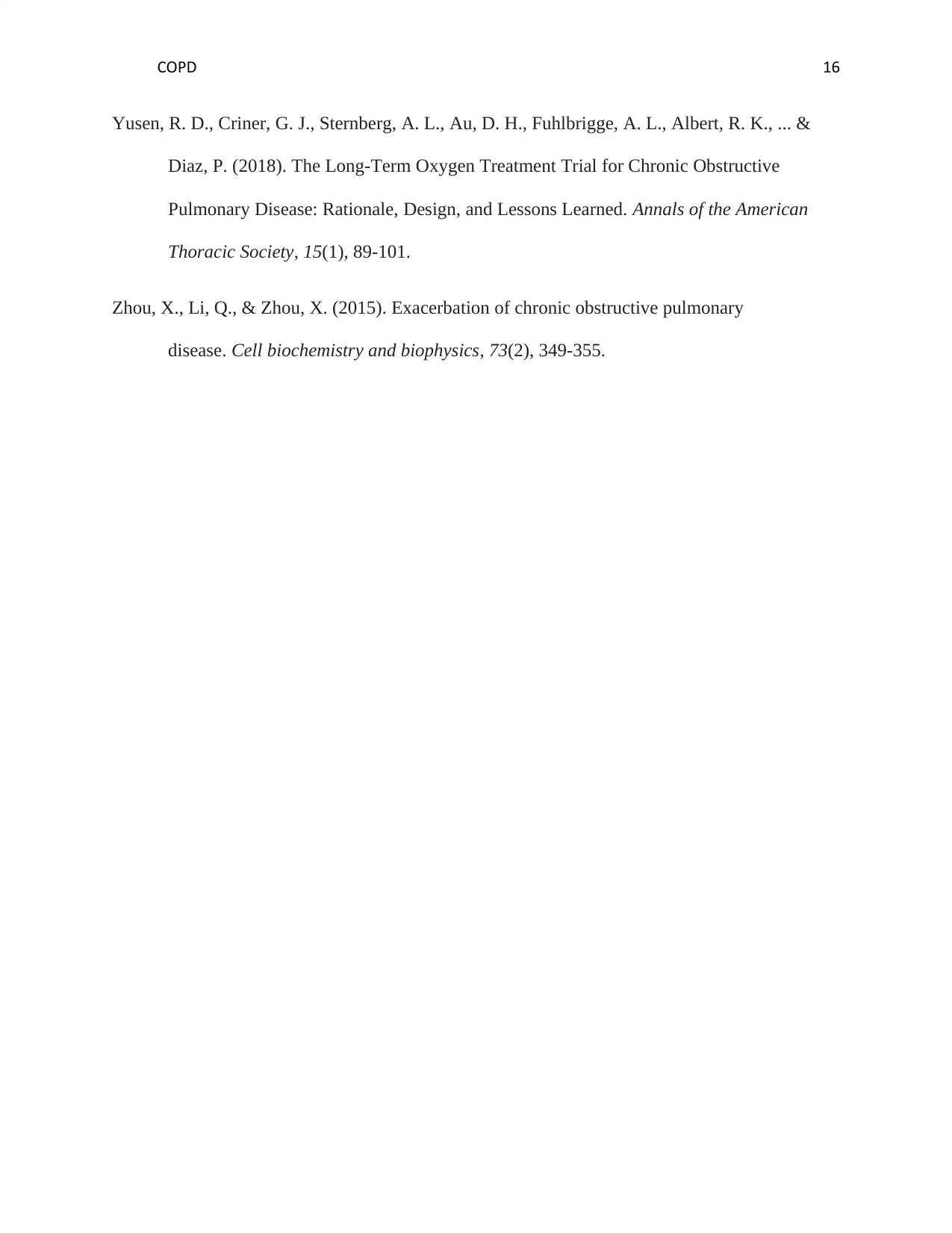
COPD 16
Yusen, R. D., Criner, G. J., Sternberg, A. L., Au, D. H., Fuhlbrigge, A. L., Albert, R. K., ... &
Diaz, P. (2018). The Long-Term Oxygen Treatment Trial for Chronic Obstructive
Pulmonary Disease: Rationale, Design, and Lessons Learned. Annals of the American
Thoracic Society, 15(1), 89-101.
Zhou, X., Li, Q., & Zhou, X. (2015). Exacerbation of chronic obstructive pulmonary
disease. Cell biochemistry and biophysics, 73(2), 349-355.
Yusen, R. D., Criner, G. J., Sternberg, A. L., Au, D. H., Fuhlbrigge, A. L., Albert, R. K., ... &
Diaz, P. (2018). The Long-Term Oxygen Treatment Trial for Chronic Obstructive
Pulmonary Disease: Rationale, Design, and Lessons Learned. Annals of the American
Thoracic Society, 15(1), 89-101.
Zhou, X., Li, Q., & Zhou, X. (2015). Exacerbation of chronic obstructive pulmonary
disease. Cell biochemistry and biophysics, 73(2), 349-355.
1 out of 16
Related Documents
Your All-in-One AI-Powered Toolkit for Academic Success.
+13062052269
info@desklib.com
Available 24*7 on WhatsApp / Email
![[object Object]](/_next/static/media/star-bottom.7253800d.svg)
Unlock your academic potential
© 2024 | Zucol Services PVT LTD | All rights reserved.





